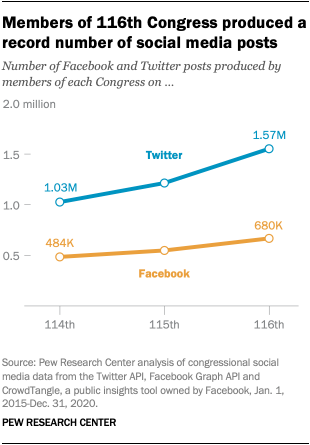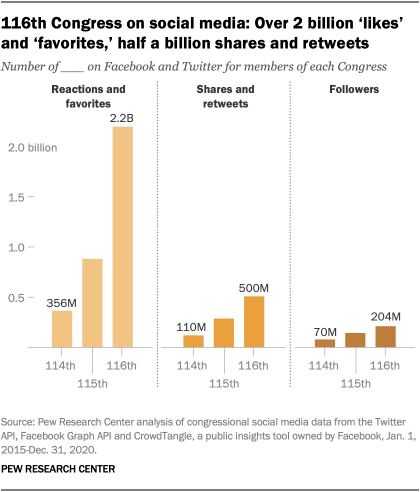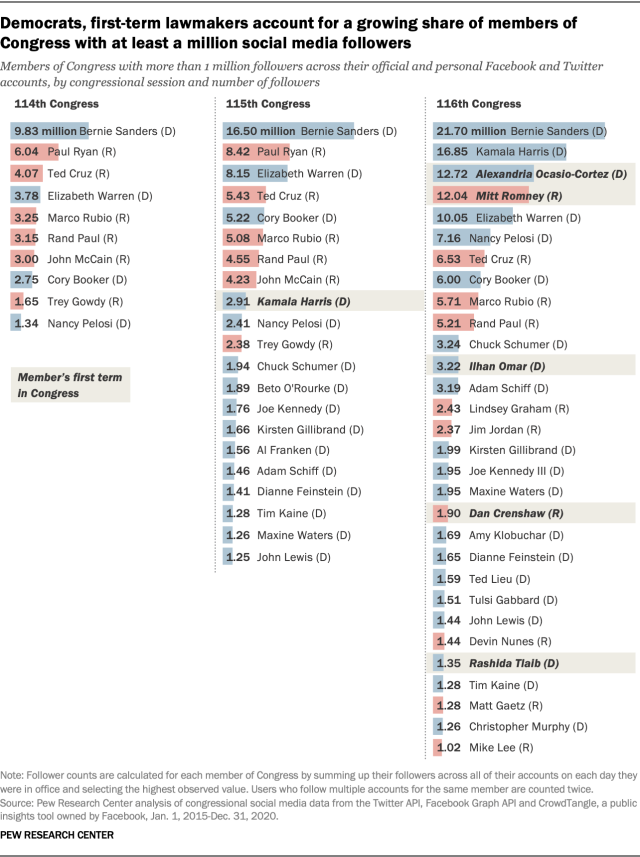The just-concluded 116th Congress wasn’t especially productive in terms of the number of substantive bills it passed during its two years in office. But it set several records for lawmakers’ use of social media, according to a new Pew Research Center analysis.
Voting members of the 116th Congress collectively produced more than 2.2 million tweets and Facebook posts in 2019 and 2020. That means the median member of Congress produced more than 3,000 posts across their profiles on the two social media platforms during this span.
In total, the 116th Congress produced roughly 738,000 more social media posts than the 114th Congress of 2015-2016, the first one for which the Center has data.
Members of Congress use social media for a variety of reasons – from sharing news and information to communicating with constituents and others about their views on important issues and real-world events.
In addition to the standard duties of their office such as conducting oversight and crafting legislation, members of Congress engage in extensive communications and public outreach on social media platforms like Facebook and Twitter. To conduct this analysis, Pew Research Center collected every Facebook post and tweet created by every voting member of the 114th, 115th and 116th Congresses between Jan. 1, 2015, and Dec. 31, 2020. The analysis includes official, campaign and personal accounts. Here is the methodology for this post.
As in years past, Twitter is the most-used congressional social media platform. Members of the 116th Congress produced more than twice as many tweets as Facebook posts during their two years in office. But posting volume on both Twitter and Facebook has risen substantially and consistently over the last three Congresses.
Related: 116th Congress had busiest post-election session in recent history
As Congress has grown more active on social media, audience engagement has increased as well. Posts from members of the 116th Congress received more than 2 billion favorites and reactions across Twitter and Facebook, as well as half a billion shares and retweets on the two platforms combined. Meanwhile, the total number of users who follow members of Congress on Twitter or Facebook has nearly tripled over the last three sessions.
Previous research by the Center has found that a small number of lawmakers with large followings account for the bulk of congressional audience engagement. And as overall engagement has exploded, the number of lawmakers with more than 1 million followers across their social media accounts has tripled over the last three legislative sessions – from just 10 such members in the 114th Congress to 30 members in the most recent Congress.
These high-follower lawmakers are not especially prolific in their posting behavior. In the 116th Congress, the 30 members who had more than 1 million followers – representing 6% of lawmakers who were active during the session – produced 10% of all congressional social media posts. But this group accounted for a majority of followers of congressional accounts, as well as audience reaction and engagement: 70% of followers, 71% of reactions and favorites and 65% of shares and retweets.
The composition of this group has also changed and evolved over the last three Congresses. The 10 members of the million-follower club in the 114th Congress contained no first-term lawmakers. But the members of the 116th Congress who had more than 1 million followers included five first-term lawmakers, as well as nine lawmakers who passed the million-follower mark over the course of the most recent Congress. The share of women in this group also increased, from 20% in the 114th Congress to 37% in the 116th. And although the million-follower club of the 114th Congress included more Republicans (6) than Democrats (4), the current membership contains twice as many Democrats (20) as Republicans (10).
Note: Here is the methodology for this post.




